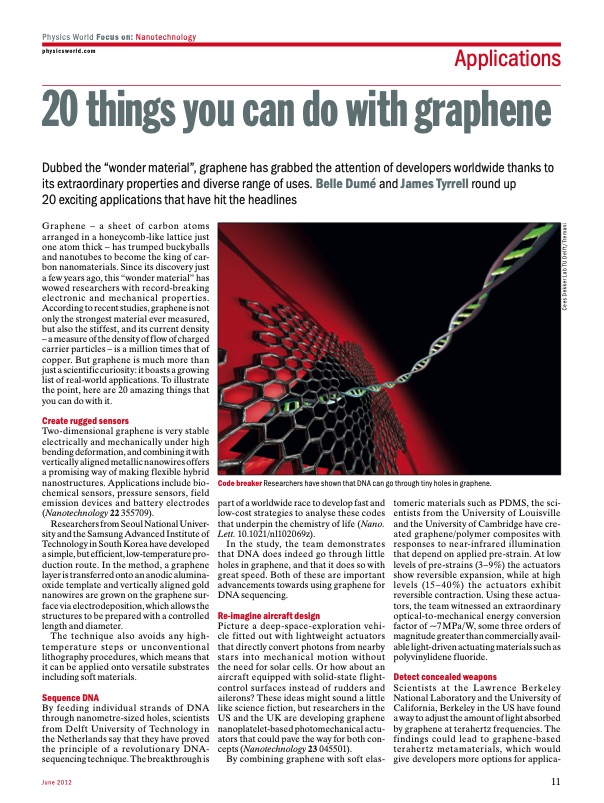
PDF Publication Title:
Text from PDF Page: 001
Physics World Focus on: Nanotechnology physicsworld.com Applications 20 things you can do with graphene Dubbed the “wonder material”, graphene has grabbed the attention of developers worldwide thanks to its extraordinary properties and diverse range of uses. Belle Dumé and James Tyrrell round up 20 exciting applications that have hit the headlines Graphene – a sheet of carbon atoms arranged in a honeycomb-like lattice just one atom thick – has trumped buckyballs and nanotubes to become the king of car- bon nanomaterials. Since its discovery just a few years ago, this “wonder material” has wowed researchers with record-breaking electronic and mechanical properties. According to recent studies, graphene is not only the strongest material ever measured, but also the stiffest, and its current density – a measure of the density of flow of charged carrier particles – is a million times that of copper. But graphene is much more than just a scientific curiosity: it boasts a growing list of real-world applications. To illustrate the point, here are 20 amazing things that you can do with it. Create rugged sensors Two-dimensional graphene is very stable electrically and mechanically under high bending deformation, and combining it with vertically aligned metallic nanowires offers a promising way of making flexible hybrid nanostructures. Applications include bio- chemical sensors, pressure sensors, field emission devices and battery electrodes (Nanotechnology 22 355709). Researchers from Seoul National Univer- sity and the Samsung Advanced Institute of Technology in South Korea have developed a simple, but efficient, low-temperature pro- duction route. In the method, a graphene layer is transferred onto an anodic alumina- oxide template and vertically aligned gold nanowires are grown on the graphene sur- face via electrodeposition, which allows the structures to be prepared with a controlled length and diameter. The technique also avoids any high- temperature steps or unconventional lithography procedures, which means that it can be applied onto versatile substrates including soft materials. Sequence DNA By feeding individual strands of DNA through nanometre-sized holes, scientists from Delft University of Technology in the Netherlands say that they have proved the principle of a revolutionary DNA- sequencing technique. The breakthrough is June 2012 Code breaker Researchers have shown that DNA can go through tiny holes in graphene. PWNANOJun12Graphene.indd 11 15/05/2012 10:15 part of a worldwide race to develop fast and low-cost strategies to analyse these codes that underpin the chemistry of life (Nano. Lett. 10.1021/nl102069z). In the study, the team demonstrates that DNA does indeed go through little holes in graphene, and that it does so with great speed. Both of these are important advancements towards using graphene for DNA sequencing. Re-imagine aircraft design Picture a deep-space-exploration vehi- cle fitted out with lightweight actuators that directly convert photons from nearby stars into mechanical motion without the need for solar cells. Or how about an aircraft equipped with solid-state flight- control surfaces instead of rudders and ailerons? These ideas might sound a little like science fiction, but researchers in the US and the UK are developing graphene nanoplatelet-based photomechanical actu- ators that could pave the way for both con- cepts (Nanotechnology 23 045501). By combining graphene with soft elas- tomeric materials such as PDMS, the sci- entists from the University of Louisville and the University of Cambridge have cre- ated graphene/polymer composites with responses to near-infrared illumination that depend on applied pre-strain. At low levels of pre-strains (3–9%) the actuators show reversible expansion, while at high levels (15–40%) the actuators exhibit reversible contraction. Using these actua- tors, the team witnessed an extraordinary optical-to-mechanical energy conversion factor of ~7 MPa/W, some three orders of magnitude greater than commercially avail- able light-driven actuating materials such as polyvinylidene fluoride. Detect concealed weapons Scientists at the Lawrence Berkeley National Laboratory and the University of California, Berkeley in the US have found a way to adjust the amount of light absorbed by graphene at terahertz frequencies. The findings could lead to graphene-based terahertz metamaterials, which would give developers more options for applica- 11 Cees Dekker Lab TU Delft/TremaniPDF Image | Graphene for Solid State Physics II

PDF Search Title:
Graphene for Solid State Physics IIOriginal File Name Searched:
graphene.pdfDIY PDF Search: Google It | Yahoo | Bing
Salgenx Redox Flow Battery Technology: Power up your energy storage game with Salgenx Salt Water Battery. With its advanced technology, the flow battery provides reliable, scalable, and sustainable energy storage for utility-scale projects. Upgrade to a Salgenx flow battery today and take control of your energy future.
| CONTACT TEL: 608-238-6001 Email: greg@infinityturbine.com | RSS | AMP |